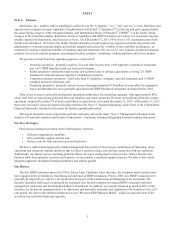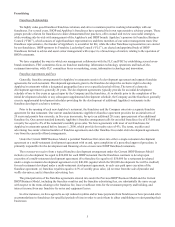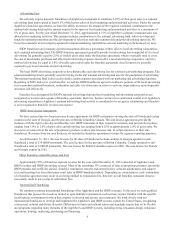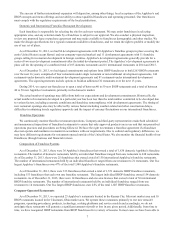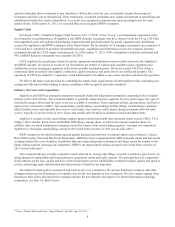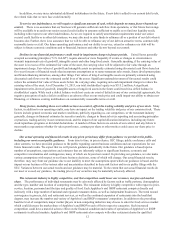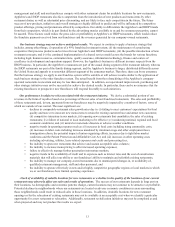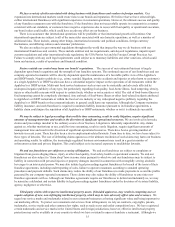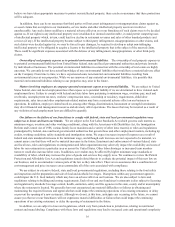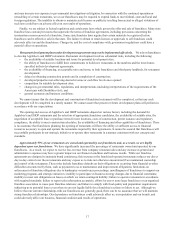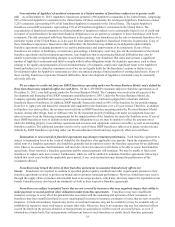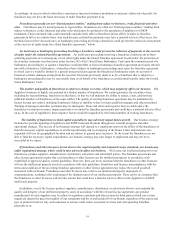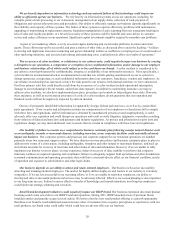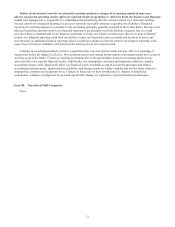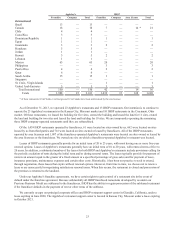IHOP 2013 Annual Report Download - page 34
Download and view the complete annual report
Please find page 34 of the 2013 IHOP annual report below. You can navigate through the pages in the report by either clicking on the pages listed below, or by using the keyword search tool below to find specific information within the annual report.13
management and staff, and our franchisees compete with other restaurant chains for available locations for new restaurants.
Applebee's and IHOP restaurants also face competition from the introduction of new products and menu items by other
restaurant chains, as well as substantial price discounting, and are likely to face such competition in the future. The future
success of new products, initiatives and overall strategies is highly difficult to predict and will be influenced by competitive
product offerings, pricing and promotions offered by competitors. Our ability to differentiate the Applebee's and IHOP brands
from their competitors, which is in part limited by the advertising monies available to us and by consumer perception, cannot
be assured. These factors could reduce the gross sales or profitability at Applebee's or IHOP restaurants, which would reduce
the franchise payments received from our franchisees and the revenues generated by our company-owned restaurants.
Our business strategy may not achieve anticipated results. We expect to continue to apply a business strategy that
includes, among other things, (i) operation of a 99% franchised restaurant system; (ii) the maintenance of a purchasing
cooperative that procures products and services for our Applebee's and IHOP restaurants; (iii) the possible introduction of new
restaurant concepts; and (iv) the continued implementation of a shared service model across the brands for various functions,
including legal, human resources, communications, quality assurance, information technology, finance and centers of
excellence in development and operations support. However, the Applebee's business is different in many respects from the
IHOP business. In particular, the Applebee's restaurants are part of the casual dining segment of the restaurant industry whereas
the IHOP restaurants are part of the family dining segment, and the Applebee's business is larger, distributed differently across
the United States and appeals to a somewhat different segment of the consumer market. Therefore, there can be no assurance
that the business strategy we apply to one franchise system will be suitable or will achieve results similar to the application of
such business strategy to the other franchise system. The actual benefit from the refranchising of the Applebee's company-
operated restaurants is uncertain and may be less than anticipated. In addition, our operational improvement, purchasing and
other strategic initiatives may not be successful or achieve the desired results. In particular, there can be no assurance that the
existing franchisees or prospective new franchisees will respond favorably to such initiatives.
Our performance is subject to risks associated with the restaurant industry. We derive a substantial portion of our
revenues in the form of royalties based on a percentage of the net sales of our franchised restaurants. The sales and profitability
of these restaurants and, in turn, payments from our franchisees may be negatively impacted by a number of factors, some of
which are outside of our control. The most significant are:
• declines in comparable-restaurant sales growth rates due to: (i) failing to meet customers' expectations for food
quality and taste or to innovate new menu items to retain the existing customer base and attract new customers;
(ii) competitive intrusions in our markets; (iii) opening new restaurants that cannibalize the sales of existing
restaurants; (iv) failure of national or local marketing to be effective; (v) weakening national, regional and local
economic conditions; and (vi) natural or man-made disasters or adverse weather conditions.
• negative trends in operating expenses such as: (i) increases in food costs including rising commodity costs;
(ii) increases in labor costs including increases mandated by minimum wage and other employment laws,
immigration reform, the potential impact of union organizing efforts, increases due to tight labor market
conditions and the Patient Protection and Affordable Care Act; and (iii) increases in other operating costs
including advertising, utilities, lease-related expenses and credit card processing fees;
• the inability to open new restaurants that achieve and sustain acceptable sales volumes;
• the inability to increase menu pricing to offset increased operating expenses;
• failure to effectively manage further penetration into mature markets;
• negative trends in the availability of credit and in expenses such as interest rates and the cost of construction
materials that will affect our ability or our franchisees' ability to maintain and refurbish existing restaurants;
• the inability to manage our company-owned restaurants due to unanticipated changes in, or availability of,
qualified restaurant management, staff and other personnel; and
• the inability to operate effectively in new and/or highly competitive geographic regions or local markets in which
we or our franchisees have limited operating experience.
A lack of availability of suitable locations for new restaurants or a decline in the quality of the locations of our current
restaurants may adversely affect our sales and results of operations. The success of our restaurants depends in large part on
their locations. As demographic and economic patterns change, current locations may not continue to be attractive or profitable.
Potential declines in neighborhoods where our restaurants are located or adverse economic conditions in areas surrounding
those neighborhoods could result in reduced sales in those locations. In addition, desirable locations for new restaurant
openings or for the relocation of existing restaurants may not be available at an acceptable cost when we identify a particular
opportunity for a new restaurant or relocation. Additionally, restaurant revitalization initiatives may not be completed as and
when projected and may not produce the results we expect.


